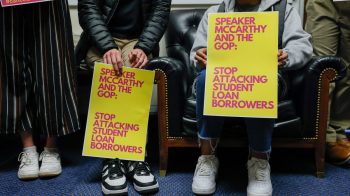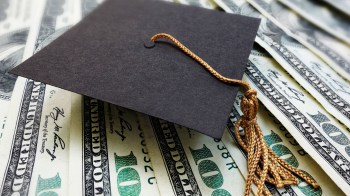New rules from the U.S. Department of Education
On Thursday, the U.S. Education Department issues new rules designed to address rising indebtedness and high default rates among graduates of for-profit vocational college programs. A new standard for graduates’ loan-payments-to-income will penalize schools that fail to measure up, threatening them with exclusion from government student loan and grant programs, including Pell Grants for low-income students and education benefits under the GI bill.
The government provides $22 billion annually to support so-called ‘gainful employment’ post-secondary education programs, according to Secretary of Education Arne Duncan.
Kai Ryssdal will interview Secretary of Education Arne Duncan. Listen to the show, or check back here for the podcast later this afternoon.
This includes training in culinary arts, truck-driving, IT, health care, auto repair and the like. Under the new rules to be issued Thursday, schools will risk being cut off from government student-assistance programs unless a typical graduate’s loan payment is less than 20 percent of their discretionary income, or 8 percent of their total earnings.
An earlier draft rule also would have set a standard for graduates’ student-loan default rates; default rates for graduates of for-profit colleges are considered excessively high by education advocates and the Obama Administration. Default rates will be tracked and publicly reported under the new rules, but won’t be a criterion for punishing schools and excluding them from government loan and grant programs.
In a statement emailed to Marketplace, the Association of Private Sector Colleges and Universities, which represents for-profit higher-education providers, rejected the new regulations as a “bad-faith attempt to cut off access to education for millions of students who have been historically underserved by higher education,” according to CEO Steve Gunderson.
“In this case, the Department favored public institutions that benefit from generous taxpayer operational subsidies, but have lower graduation rates and higher default rates, over programs at private sector institutions where graduates are achieving real earning gains and successfully repaying their loans,” according to the statement.
The industry has been critical of the Education Department for allegedly favoring publicly-funded community colleges over for-profit colleges that specialize in career training.
Consumer advocates also criticized the revised regulations that the Education Department has settled on.
“The final gainful employment regulation does not do enough to stop the fleecing of students and taxpayers,” said Pauline Abernathy, vice president of The Institute for College Access & Success, in an emailed statement. “In particular, the final regulation lets programs where most students borrow but few graduate keep using taxpayer dollars to bury students in debt they can’t repay, so long as they limit the debt of the few students who complete.”
There’s a lot happening in the world. Through it all, Marketplace is here for you.
You rely on Marketplace to break down the world’s events and tell you how it affects you in a fact-based, approachable way. We rely on your financial support to keep making that possible.
Your donation today powers the independent journalism that you rely on. For just $5/month, you can help sustain Marketplace so we can keep reporting on the things that matter to you.


















